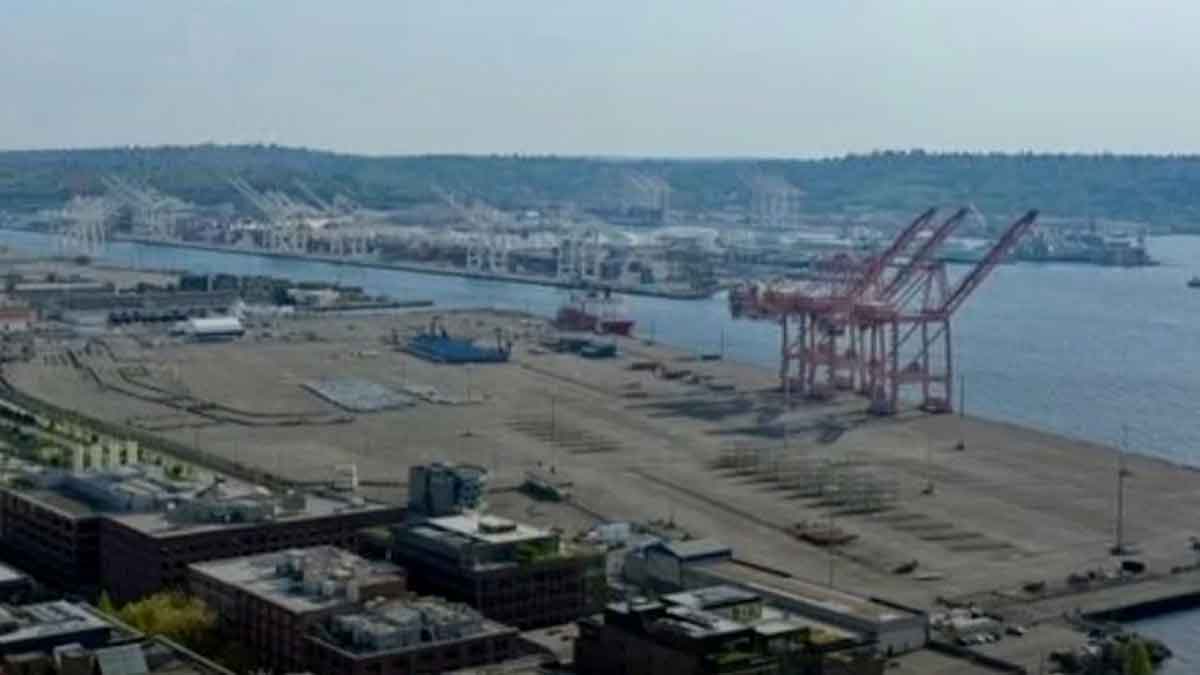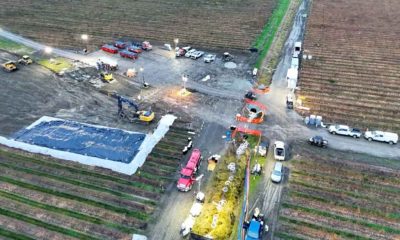Local
Is the Port of Seattle a Tariff-caused Ghost Town
The Internet claims that the Port of the Seattle is a “ghost town.” Not so fast, because the truth lies in the middle.

There have been many claims on TikTok and Facebook that there are no ships at the Port of Seattle, and pictures have been shared showing completely empty terminals with no shipping containers.
The claims are encouraging people to panic buy before facing empty shelves in one to two weeks, with the Port of Seattle illustrating the looming tariff-created consumer Armageddon.
But is it true?
Our team went down to the Port of Seattle to see for ourselves, talked to shipping experts, and reviewed port operations over the last six years. The truth usually lies in the middle, and that’s the case here.
The Port of Seattle has five terminals: Terminal 5, Terminal 13, Terminal 18, Terminal 30, and Terminal 86, the Grain Terminal, in Queen Anne.
Videos and posts claiming there are no ships or containers at the Port of Seattle show Terminal 46, which is off East Marginal Way, west of T-Mobile Park and Lumen Field. Hanjin Shipping Company operated the terminal until it went bankrupt in 2019. Since the bankruptcy, the 84-acre compound has not supported shipping traffic, and in mid-2023, the lot transitioned to storing new cars.
While the pictures circulating on social media showing a barren Terminal 46 with a U.S. Coast Guard vessel docked south of the cranes are authentic, they misrepresent the situation at the other terminals, which cover 500 acres, run by the Port of Seattle.
In 2023, the Northwest Seaport Alliance rejected a U.S. Coast Guard bid to buy 54 acres of Terminal 46, hoping that SSA Marine, which operates the terminals at the Port of Seattle, would lease the property. By mid-March, it was increasingly unlikely that Terminal 46 would be leased due to a long-term trend of declining traffic at the port and the need to replace the aging cranes.
In December 2024, the Port of Seattle Authority announced that Terminal 30 would close on January 1st due to third-party lawsuits over water quality and a years-long decline in traffic to the port. All shipping has been diverted to Terminal 5.
Traffic at the Port of Seattle has been in decline since 2018
After peaking in 2018, cargo traffic at the Port of Seattle has been in decline. There was a partial recovery after the COVID-19 pandemic ended, but cargo volumes in 2024 were almost 25% below the 2018 peak. At its height, 3.8 million 20-foot equivalent units (TEUs) – that’s how cargo is measured – passed through Seattle. In 2024, the volume dropped to 2.97 million TEUs.
Shipping traffic has dropped so low in Seattle that SSA Marine, that is the company that runs the terminals at the Port of Seattle, only operates four days a week. That started in late 2023. In January, they added a fifth day due to increased ship traffic caused by the incoming Trump administration’s intention to implement tariffs.
In 2024, the Port of Tacoma had more traffic than Seattle
In addition to the five cargo terminals, the Port of Seattle runs the cruise ship terminals at Piers 66 and 91, Seattle-Tacoma International Airport, the Port of Seattle, and the Port of Tacoma. While shipping traffic in Seattle has been on the decline, traffic in Tacoma has increased. By the end of 2024, TEUs at Tacoma exceeded Seattle by 33%.
By itself, the Port of Seattle is the seventh largest on the West Coast. Combined with Tacoma, it becomes the third largest behind Los Angeles and Long Beach, both in California.
The Port of Seattle is not a “ghost town”
Our April 29 inspection of Terminals 5, 13, and 18 revealed that three ships were being unloaded at the Port of Seattle. There were fewer cargo containers, particular in the area between State Highway 99 and East Marginal Way south of the stadiums, while other areas operated as normal.
Some of the railroad sidings at the port and along Highway 99 were empty, but it is important to note that our visit captured a single moment in time. At the time of our visit, there were no cargo ships anchored along Alki Beach in Elliott Bay, waiting to be loaded or unloaded.
We also saw significant truck activity inside and outside of the port, with containers leaving and arriving. Most of the activity was at Terminal 5.
According to the Northwest Seaport Alliance Cargo Operations website, 35 vessels are scheduled to arrive in Seattle from April 28 to May 24.
Most economists expect worsening supply chain disruptions in May
While the claims that the Port of Seattle is a “ghost town” are exaggerations, most economists and supply chain experts expect increasing problems as cargo ship traffic to U.S. ports is set to decline by 30% in May.
Analyzing monthly port utilization is challenging because many companies increased their orders in late 2024 and the first two months of 2025, increasing shipping traffic. On Wednesday, the Commerce Department’s Bureau of Economic Analysis reported that the U.S. economy shrank 0.3% in the first quarter of 2025, caused by a 41.3% surge in imports.
Now that global tariffs have been in place for almost a month, an increasing number of companies are delaying or canceling their orders. The surge of orders at the end of the year boosted cargo data. For now, the pullback is essentially a wash.








